Two &Half Days of Saigon Culture
When I first flew into Tan Son Nhat International Airport in Ho Chi Minh City, remembered fondly as Saigon, the weather was pleasantly warm-820F with some clouds. Visiting for the very first time, I tried to strike up a conversation with the taxi driver about the city. It struck me as revealing that taxi cab drivers I came across (at least two out of three), voiced a feeling of nostalgia for the old Saigon under American occupation. After 30 years of independence, there is still leftover animosity towards the north when touching on the history of old Vietnam. But looking back at how Vietnam finally became a republic, I could begin to understand why.
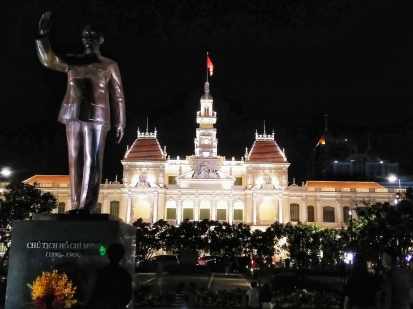
This animosity could have stemmed mainly from differences in ideology and geography between the old North and South Vietnam, but mainly from the brutalities of the civil war itself. Back then, North Vietnam was essentially a socialist (Marxist-Leninist) state while the South was a non-communist state, a largely Buddhist or Confucian state. In 1954 when the French and the American forces were defeated, Vietnam was divided into North and South, with Ho Chi Minh (Fig 1) put in charge of the North and Emperor Bao Dai put in charge of the South. But when Saigon, capital of South Vietnam, fell to the Communist in 1975, it was renamed Ho Chi Minh City and Vietnam became a unitary Marxist-Leninist one-party socialist republic.
The North and South differ in many ways, especially topography (North more natural beauty, bordering the mountains of China), weather (winter temperatures can go down such that you would need a winter coat in the North), culinary, dressing (more subtle dressing in the North compared to the South), language etc.
I found three cultures unique to Ho Chi Minh city. One is surely the motor culture. In a city where pavements are dominated by motorcycles, a proper walking space, free of motorbikes is a welcome. Nguyen Hue Street is busy with a different kind of crowd at night (Fig 1). I noticed during the nights, the crowd would come here to socialize, sing, dance and ride boards. 900 meters opposite is located the Saigon River
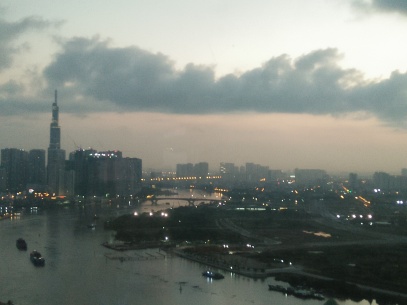
We had a most challenging experience of our lives in an attempt to cross Ton Duc Thang Street (a main street) to get to the bank of the Saigon River. Street crossing is almost life threatening in Ho Chi Minh. I agree that it was after-office hours, and probably the wrong time to cross a main street filled with endless motor cycles, cars and buses. None of the vehicles stopped and we were advised to just go with the flow with steady steps. It seemed that vehicles will naturally manoeuvre around you as you cross. But I was not about to take any chances. So I had a local help me cross the street.
About figure – The Saigon River,at dawn, as seen from the Reverie Saigon on Nguyen Hue Street. Barges ply the river carrying sand and construction materials down the river. Water taxi is a common sight on the river bank.
Then there is the scooter tour also unique to Ho Chi Minh City. The scooter tour is part night excursion and part street food adventure. Biking is the fastest way to get around the city but it is not for the faint-hearted. Your life depends on the expertise of the scooter driver turning and snaking around the traffic on the streets of the city. I did not have the time to try one scooter tour though.
The third culture is the street food culture. Along the alleyways, you can find blue chairs (Fig 3) lined up to sit patrons to enjoy their pho (noodle soup) or bun bo hue (beef noodle soup) or com tam, broken rice with grilled pork. Pho is cooked using fish sauce, spices, onions and ginger to give that special flavour, using either beef or chicken. I read delicious remarks by LegalNomads recommending street food. But knowing that these soups may have blood cubes and intestines added, I was not about to try any of it.
One of the few historical buildings we visited was the Central Post Office in District 1 (Fig 4 & 5). The post office first opened for service in 1864 but its architecture reflected those of the French colonial architecture.
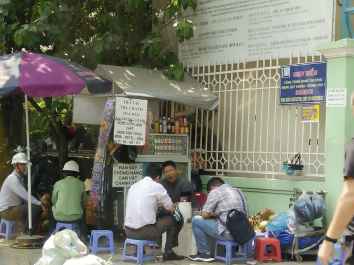
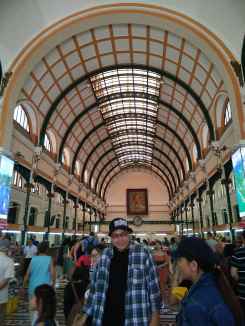
A typical scene along the streets in Ho Chi Minh city. These locals, after working hours, were drinking local coffee, while seated on blue chairs along the street. This is coffee culture.
About – figure: The Central Post Office, located close to the Notre Dame Basilica, the central cathedral. This beautiful building was constructed during French Indochina in 19th century.
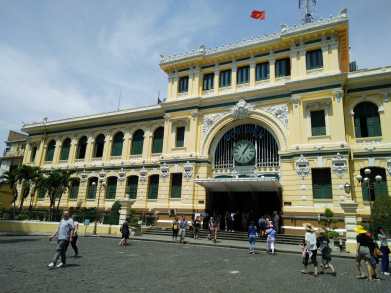
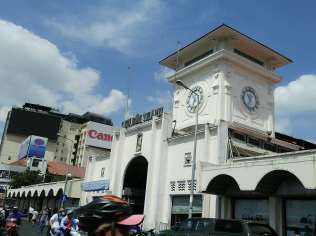
About figure: Inside the Ben Thanh Market, teeming with local products and swarming with shoppers. Caucasian tourists have learned the art of negotiation in Ben Thanh. A trader offered me a tailored suit for RM300. Now was that cheap?
Ben Thanh is very popular with the Malaysian shoppers who fly in just for a two day shopping spree. In fact in front of the Ben Thanh market (Fig 6) is a street called Nguyen An Ninh Street , fondly named the Malaysian Street because of the endless patronage by Malaysian tourists. On this street too, there are halal cafes and restaurants.
Another historic place we visited was the War Remnants Museum in District 3. It is a sad reminder of the atrocities of war. The museum (Fig 7) exhibited gruesome photos of war victims where the use of, among other weapons, Agent Orange which contains the deadly toxin dioxan. Exposure to dioxan cause cancers and lasting health problems . The war called the Second Vietnam War (or Second Indochina War) is also called the American War. It lasted for 20 years from 1955 to 1975. The Second Vietnam War is one of the 27 wars or armed conflicts America has engaged in with two still on-going. American presidents constantly used the domino theory to rationalize their involvement in wars across the globe. With South Vietnam, it was President Eisenhower who used the theory as an argument to justify increasing American military involvement in South Vietnam.
It seemed that during the Vietnam War, many South Vietnamese fled the country to migrate to countries like Australia, America etc. After 40 years, many of the descendants of these refugees came back to Vietnam, mainly South Vietnam. These Vietnamese are called Overseas Vietnamese or Viet Kieu (https://culturetrip.com). They are mostly settled in Ho Chi Minh city. They look Vietnamese, but speak perfect English with American or Australian accent. And with this migration, comes the American fast-food life style. In the South you can find many fast-food restaurants like KFC, Burger King and even McDonalds…..an American lifestyle that is creating an upward trend in obesity. Foreigners (Japanese and Koreans mainly) working and living in Vietnam, live in the South, mostly in and around Ho Chi Minh City.
About figure: Schoolchildren resting next to a tank, at the War Remnants Muzeum in District 3, Ho Chi Minh City.
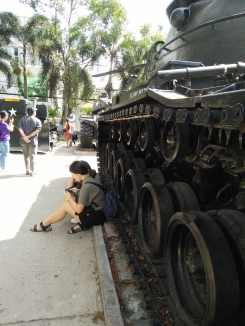
However, I was more interested to meet another group of Vietnamese while in Ho Chi Minh City….the Cham Malays. The Cham Malays is a minority ethnic group found mainly in South Vietnam. This interest stemmed mainly from the knowledge that back in Malaysia, there is a village in Terengganu where Cham Malays live. In fact later I was to find out there are many places in Malaysia where Cham Malays are found such as Jalan Bayam in Kelantan, Batu Pahat in Johor, Pekan in Pahang, Sungai Buloh in Selangor.
Dr Basiron (Fig 8) is a Cham Malay living and running a halal certification company in Ho Chi Minh city. He is 40 years old, with a PhD in Arabic studies. He studied in a Malaysian Islamic university and speaks five languages namely Vietnamese, Malay, English, Arabic and Khmer language. He was soft spoken and spoke English fairly well. We decided to take a slow walk towards Ben Thanh market. In fact in front of the Ben Thanh market (Fig 6) is a street called Nguyen An Ninh Street , fondly named the Malaysian Street because of the endless patronage by Malaysian tourists. On this street too, there are halal cafes and restaurants.
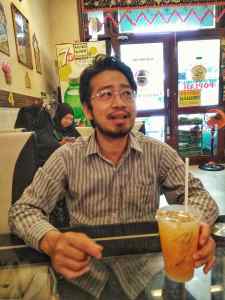
About figure: Dr Basiron, at the halal restaurant on Nguyen An Ninh Street, Ben Thanh Ward in District 1. Nguyen An Ninh is sometimes called Malaysian Street due to popular patronage by Malaysian shoppers.
Dr Basiron is one of the fortunate Cham Malays, educated and running a small business. Halal certification is important with Vietnam’s growing Muslim tourism. There are about 72,000 Muslims in Vietnam, making up 0.1% of the country’s population of 95 million. Muslims in Vietnam are of three groups:1) Cham people; 2) inter-racial Muslims (who are offspring of mixed marriages between Vietnamese and Muslim traders) and 3) those who converted to Islam after interacting with Muslim traders (extracted from the writing by Tan Jo Hann). Ever since the French colonial rule to the end of the Vietnam war in 1973, the Cham Muslims have been victims of forced assimilation. Categorized as ethnic minority, the Cham Muslims are depicted as “poor”, “backward” and “deficient”. Perhaps Dr Basiron represents the new generation of Cham Muslims in South Vietnam…educated and independent.
I also noticed some young locals eating while seated on the pavements. I saw this while on my way to the central Musulman mosque on Dong Du street. I was more inclined to eat at the Nyonya restaurant on Dong Du owned by a Malaysian entrepreneur and run by a Malaysian Chinese, especially their seafood char kuey teow. Down the Dong Du street, opposite the Musulman Masjid, is the Turkish kebab shop. I ate there once but I could not convince Dr Basiron to step inside.
Ho Chi Minh City, District 1, has unique cultures worth experiencing, without a doubt. If you are a shopper, the city is an attractive shoppers paradise. But Hanoi would probably be more attractive to a traveller who loves nature. Jaw dropping natural wonders would be more my thing.
